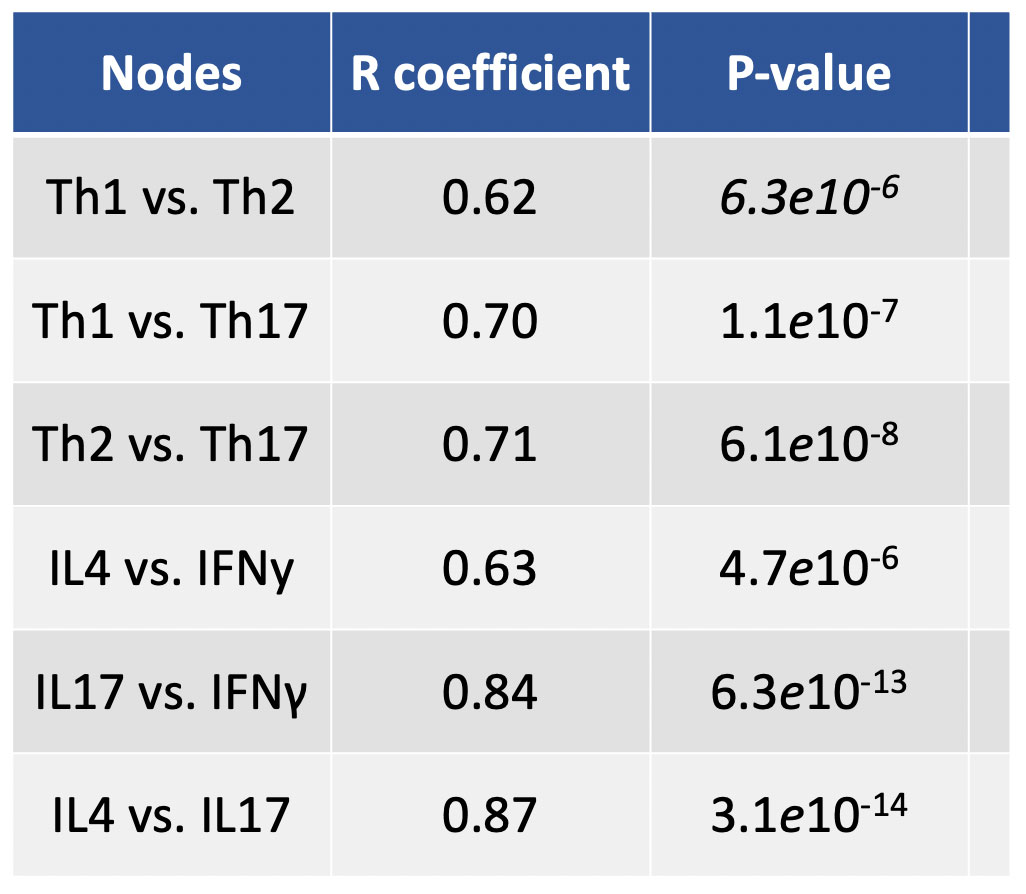Session Information
Session Type: Poster Session B
Session Time: 9:00AM-10:30AM
Background/Purpose: The immunopathogenesis of cutaneous lupus erythematous (CLE) is highly diverse and involves activity of many different cell types and pathways. This heterogeneity is believed to be largely responsible for unpredictable treatment response between patients. Here we used a correlation network model approach to map the relationships between different cell types and pathway proteins in CLE skin biopsies.
Methods: Here we profiled 44 CLE biopsies using multiplexed imaging mass cytometry to characterize the cell and pathway composition of CLE infiltrate. Biopsies were stained with two different panels of 37-metal conjugated antibodies that served as markers for different cell types, cytokines and pathway proteins. The relationships among cell and cytokine immune markers were modeled using Gaussian graphical model. The values were log-transformed and standardized prior to the analysis. The GGM algorithm identifies and displays only significant correlations between markers while leaving out non-significant ones. The algorithm then graphs the markers as a network and spatially arranges them by correlation strength so that the strongest associated markers are within closest proximity. This spatial orientation allows for distinction between direct and indirect associations of cell types or pathway proteins.
Results: Of our network consisting of 11 T-cell subtypes, GGM identified Th1, Th2 and Th17 to be inter-related with each other, forming a triangle. No other positive findings were found between any other cells, including our main cell network consisting of 11 common immune cell types. Of our cytokine/pathway network consisting of 16 different markers, GGM identified IL4, IL17 and IFN???? to be among the strongest related markers in the network. Correlation testing confirmed remarkably strong associations between IL4, IL17 and IFN???? (all 3 pairs were p< 1×10-13) as well as significant correlations (p< 1×10-6) amongst all possible permutations of the aforementioned GGM-significant markers. Furthermore, heatmap visualization of T-cell K-means clustering was also performed and revealed the majority of patients (n=27) to be Tem dominant (83% CD4 and 76% CD8), with a smaller subgroup (n=14) to being Tcm dominant (57% CD4 and 50% CD8).
Conclusion: These findings suggest that Th1, Th2 and Th17 co-occur together in the pathogenesis of CLE. Th1 and Th2 responses have traditionally been thought of as separate and antagonistic to each other. Our study challenges this dualism. In treating CLE patients with increased T-cell activity, it may be necessary to tackle both Th1 and Th2 along with Th17 responses together.
To cite this abstract in AMA style:
Chin F, Vazquez T, Dan J, Diaz D, Sprow G, Patel J, Kodali N, Feng R, Werth V. Partial Correlations Network Models Show Th1, Th2 and Th17 Responses to Be Interlinked in Dermal Pathogenesis of Cutaneous Lupus Erythematous [abstract]. Arthritis Rheumatol. 2022; 74 (suppl 9). https://acrabstracts.org/abstract/partial-correlations-network-models-show-th1-th2-and-th17-responses-to-be-interlinked-in-dermal-pathogenesis-of-cutaneous-lupus-erythematous/. Accessed .« Back to ACR Convergence 2022
ACR Meeting Abstracts - https://acrabstracts.org/abstract/partial-correlations-network-models-show-th1-th2-and-th17-responses-to-be-interlinked-in-dermal-pathogenesis-of-cutaneous-lupus-erythematous/



